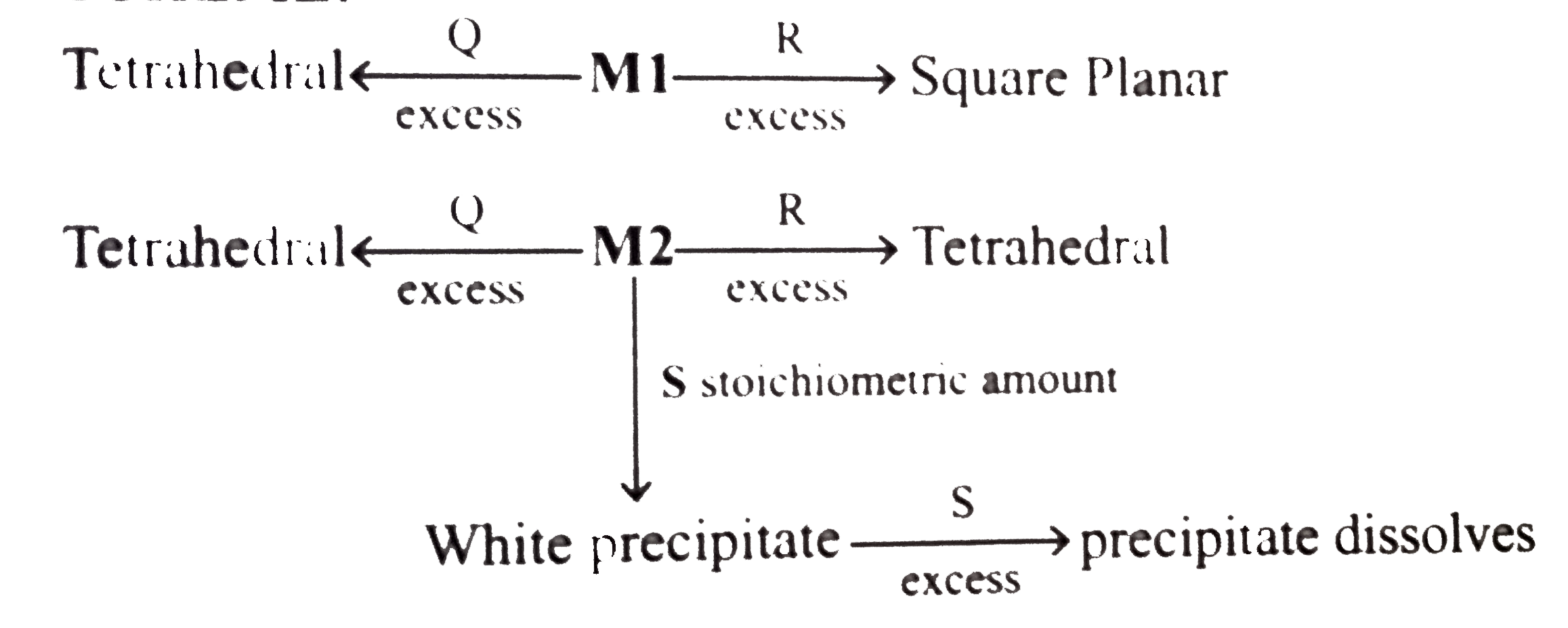Complete Solutions to Question Bank (Building the knowledge) of chapter COORDINATION COMPOUNDS of Class 12 book with complete answers and questions
| Class 12 | CHEMISTRY |
| Chapter | COORDINATION COMPOUNDS |
| R SHARMA | Question Bank (Building the knowledge) |
| Number Of Questions | 38 |
| Academic Year | 2023-24 |
The number of geometrical isomers for `[Pt(NH_(3))_(2)CI_(2)]` is
01:54View SolutionThe coordination number and oxidation state of Cr in `K_(3)[Cr(C_(2)O_(4))_(3)]` an respectively
01:46View SolutionIn metal carbonyl having and genral formula `M(CO)_(x)`, where, M = metal, x = 4 and the metal is bonded to
01:37View SolutionWhich of the following ligands is expected to bidentates?
01:13View SolutionThe number of ions formed form a formula unit of potassium ferricyanide in solution is
01:10View SolutionWhich of the following is a hexadentate ligand ?
02:15View SolutionThe IUPAC name of `[Co(NH_(3))_(5)(NCS)]CI_(2)` is
03:04View SolutionWilkinson's catalyst has the formula
02:28View SolutionTetrahedral complexes of the types of `[MA_(4)]` and `[MA_(3)B]` (where M = central metal, A,B = achiral ligands) are not able to show optical isomerism because
02:02View SolutionThe number of unpaired spins in the `[Cr(en)_(3)]^(2+)` ion is
02:52View SolutionWhich of the following is paramagnetic and squre planar ?
04:02View SolutionThe magnitude of crystal field stabilization energy (CFSE) in tetrahedral complexes is considerably less than in the octahedral field beause
01:53View SolutionA coordination compound of cobalt has the molecular, formula containing five ammonia molecules, one nitro group and two chlorine atoms for onew cobalt atom. One mole of this compounds three ions in an aqueous solution. On reacting this solution with excess of `AgNO_(3)` solution, we get two moles of AgCI precipitate. The ionic formula for this complex would be
02:33View SolutionIUPAC name of `[Pt(NH_(3))_(3) (Br)(NO_(2))CI] CI` is
03:49View SolutionThe number of geometrical isomers of the complex `[Co(NO_(2))_(3) (NH_(3))_(3)]` is
02:05View SolutionThe formula of dichlorobis (urea) copper (II) is
01:13View SolutionThe complex ion `[Co(NH_(3))_(6)]^(3+)` is formed by `sp^(3) d^(2)` hybridiration. Hence, the ion should posses
01:14View SolutionConsider the follwing complexes ion `P,Q` and `R`
`P =[FeF_(6)]^(3-), Q=[V(H_(2)O)_(6)]^(2+)` and `R=[Fe(H_(2)O)_(6)]^(2+)`
The correct order of the complex ions, according to their spin only magnetic moment values (inBM) is .04:27View SolutionThe number of geometric isomers that can exist for square planner complex ion `[Pt(CI)(PY)(NH_(3))(NH_(2)OH)]^(+)` is (Py = pyridine) :
01:43View SolutionIf the freezing point of a `0.01` molal aqueous solution of a cobalt (III) chloride-ammonia complex (which behaves as a strong electrolyte) is `-0.0558^(@)C`, the number of chloride (s) in the coordination sphere of the complex if `[K_(f)` of water `=1.86 K kg mol^(-1)]`
02:58View SolutionIn the complex ion `[Fe(H_(2)O)_(5)NO]^(2+)`
01:32View SolutionWhich of the following statements is incorrect regarding the stereisomerism of the complexes note below (where M statids for a metal, and A, B, C and D are achiral ligands) ?
02:58View SolutionWhich of the following coordination entities are more stable for strong forld as compared to weak field cases ?
02:12View SolutionThe total number possible isomers for the complex compound `[Cu^(II)(NH_(3))_(4) [Pt^(II)CI_(4)]` are
02:09View SolutionWhich of the folloiwng complexes in not expected to exhibit optical isomerism? .
03:55View SolutionThe octahedral complex of a metal ion `M^(3+)` with four monodentate ligands `L_(1),L_(2),L_(3)` and `L_(4)` absorb wavelengths in the region of red,green, yellow and bule, respectively The increasing order of ligand strengh of the four ligands is
03:15View SolutionThe equation which is balanced and represents the correct product(s) is .
02:52View SolutionIn the complex acetylbromidodicarbonyl bis (triethyphospine) iron (II), the number of Fe -- C bonds (s) is
00:58View SolutionAmong the complex ions,
`[Co(en)_(2)CI_(2)]^(+)` , `[CrCI_(2)(C_(2)O_(4))_(2)]^(3-)` , `[Fe(H_(2)O)(OH_(2)]^(+)` , `[Fe(NH_(3))_(2) (CN)_(4)]^(-)` `[Cp(en)_(2)(NH_(3))CI]^(2+)` and `[Co(NH_(3))_(4)(H_(2)O)CI]^(2+)` ,
the number of complex ion(s) that show (s) cis-trans isomerism isView SolutionWhich of the following is a bidentate ligand ?
(i) Acetylacetonate (ii) Glycinato
(iii) Oxalato (iv) Carbanato02:40View SolutionThe IUPAC name of the complex `[Cu(C_(5)H_(7)O_(2))_(2)]` formed bby the reaction between `Cu^(2+)` and acetylacetone is
02:07View SolutionThe IUPAC name for `[(NH_(3))_(5)Cr - (OH) - Cr(NH_(3))_(5)]` is
02:04View SolutionThe pair(s) of coordination complexes/ion exhibiting the same kind of isomerism is (are):
(i) `[Cr(NH_(3))_(5)CI]CI_(2)` and `[Cr(NH_(3))_(4)CI_(2)]CI`
(ii) `[Co(NH_(3))_(4)CI_(2)]^(+)` and `[Pt(NH_(3))_(2)(H_(2)O)CI]^(+)`
(iii) `[CoBr_(2)CI_(2)]^(2-)` and `[PtBr_(2)CI_(2)]^(2-)`
(iv) `[Pt(NH_(3))_(3)(NO_(3))]CI` and `[Pt(NH_(3))_(3)CI]Br`02:56View Solution`EDTA^(4-)` i9s ethylenediamine tetraacetate ion The total number of `N-CO-O` bond angles in `[Co(EDTA)]^(-1)` complex ion is .
03:40View SolutionWhich of the following compounds is not yellow coloured ?
04:16View SolutionFor the octahedral complex of `Fe^(+)` in `SCN^(-)` (thiocyanato-S) and in `CN^(-)` ligand environments, the difference between the spin - only magnetic moments in Bohr magneton (when approximated to the nerest integer) is `[At. No . of Fe = 26]`
04:39View SolutionAn aqueous solution of metal ion `MI` reacts separately with reagents `Q` and `R` in excess to give tetrahedral and square planar complexes, respectively An aqueous solution of another metal ion `M2` always forms tetrahedral complexs with theses reagents. Aqueous solution of `M2` on reaction with reagent `S` gives white precipitate which dissolves in excess of `S` The reactions are summarised in the scheme given below: `SCHEME` :

what is M2 and S??03:41View Solution`AIF_(3)` is soluble in `HF` only in presence of `KF`. It is due to the formation of
04:01View Solution
Question Bank (Building the knowledge) questions and complete solutions for chapter COORDINATION COMPOUNDS of R SHARMA CHEMISTRY (HINGLISH) of Class 12
